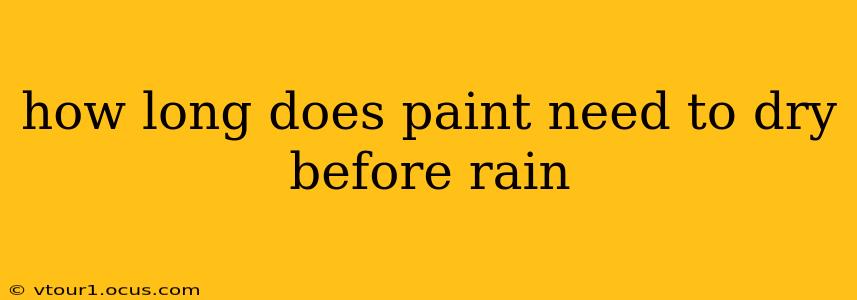Painting a house, fence, or any outdoor project is a rewarding experience, but the weather can quickly derail your plans. Knowing how long your paint needs to dry before rain is crucial to prevent a costly and frustrating redo. This guide will break down the drying times for different types of paint and offer valuable tips to protect your fresh coat from a sudden downpour.
What Factors Affect Paint Drying Time?
Before diving into specific drying times, it's important to understand the factors that influence how long paint takes to dry:
- Type of Paint: Oil-based paints generally take longer to dry than water-based (latex) paints. Alkyd paints (a type of oil-based) also have varying drying times depending on the formulation.
- Paint Thickness: Thicker coats naturally require more time to dry than thinner coats. Multiple thin coats are always better than one thick coat.
- Temperature: Warmer temperatures accelerate drying, while cooler temperatures slow it down. High humidity also hinders the drying process.
- Air Circulation: Good ventilation helps the paint dry faster by allowing moisture to evaporate more quickly. A breezy day is ideal for painting.
- Surface Type: Porous surfaces like wood absorb paint more quickly, leading to faster drying. Non-porous surfaces, such as metal, may take longer.
- Type of Primer: Using a primer appropriate for the surface and paint type can significantly impact drying times.
How Long Does Different Types of Paint Need to Dry Before Rain?
The "dry to the touch" time, which is often the shortest timeframe, isn't sufficient protection from rain. You need to wait significantly longer for the paint to fully cure. This is when the paint is truly resistant to water damage.
Water-Based (Latex) Paints:
- Dry to the touch: 1-2 hours
- Recoat time: 2-4 hours
- Full cure: 2-4 weeks (this is the crucial time to avoid rain damage). The paint can appear dry but is still vulnerable to rain for the full cure time.
Oil-Based Paints:
- Dry to the touch: 6-24 hours (dependent on temperature and thickness)
- Recoat time: 24-72 hours
- Full cure: 4-8 weeks (and sometimes longer, especially in colder climates). Oil-based paints are far more susceptible to damage from rain during the curing process.
What Happens If Rain Gets on Freshly Painted Surfaces?
Rain falling on wet paint can cause several problems:
- Streaking and uneven texture: Rainwater can dilute the paint, leading to an uneven finish with streaks and blotches.
- Peeling and flaking: Moisture can weaken the bond between the paint and the surface, resulting in premature peeling and flaking.
- Mold and mildew growth: Standing water on the paint provides an ideal environment for mold and mildew to develop.
- Delayed curing: Rain can significantly prolong the curing process, leaving your painted surface vulnerable for a longer period.
How to Protect Your Fresh Paint from Rain?
Here are several strategies to protect your newly painted surfaces from rain:
- Check the weather forecast: Always check the forecast before you begin painting and plan your project accordingly.
- Paint in optimal conditions: Choose a day with low humidity and warm temperatures for optimal drying.
- Use a tarp or plastic sheeting: Cover your painted surfaces with a waterproof tarp or plastic sheeting immediately after painting if rain is anticipated.
- Paint in smaller sections: If rain is likely, paint in smaller sections so you can cover each area quickly.
- Consider postponing the project: The best approach is often to simply postpone painting if the weather forecast predicts rain.
Can I repaint if rain gets on the paint?
If rain falls on your freshly painted surface, wait until the paint has completely dried, then assess the damage. Minor issues might be easily corrected with a light sanding and a touch-up coat. However, if significant damage occurs (peeling, streaking), you might need to remove the affected paint completely and start over. This underscores the importance of allowing sufficient drying time and taking preventative measures.
By carefully considering the factors outlined above and taking appropriate precautions, you can ensure your painted surfaces last for years to come, protected from the elements. Remember, prevention is always better than cure!
